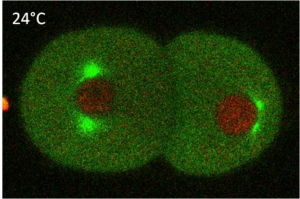Role of Daf-2 insulin signaling in the embryonic elongation of C. elegans, a daf-2 loss of function seems to vary according to the allele involved, highlighting the potential of thermosensitive mutants in studies.
Insulin-like growth factor is essential for the development of C. elegans embryo. In this publication of Annu Suresh and Bruce Wightman, by using thermosensitive mutants, they observed differences in phenotypes coming for several daf-2 receptor to observe the differences between mutations on daf-2 receptor. Previous studies have already shown a daf-2 implication in embryo elongation. They push further by suggesting a role of daf-2 in the mechanistic process of elongation and not interfering in the initial differentiation or patterning of the hypodermal cells. Other mutations on daf-2 can lead to the same elongation defects supporting a role for daf-2 insulin signaling in the embryonic elongation process. This work highlight the potential of thermosensitive mutants in C. elegans embryo studies

Ultra fast temperature shift device for in vitro experiments under microscopy
Abstract
Waddington’s Epigenetic Landscape provides a visual model for both robust and adaptable development. Generating and exploring a Waddington epigenetic landscape for the early C. elegans embryo suggests that the key shapers of the landscape are genes that lie at the nexus between stress response and behavior and include genes that are regulated by transgenerational neuronal small RNAs. Curiously, several genes shape the early landscape of one lineage and then pattern, differentiate or are enriched in another lineage. Additionally, paralogs with similar expression profiles contribute differently to shaping the modeled landscape. This work suggests that robust embryonic development is initialized by differential deployment of redundant genes and by transgenerational cues that configure the epigenetic landscape to adapt to a changing world.
References
FAQ
Insulin-like growth factor is a necessary component for the development of the C. elegans embryo. The Daf-2 insulin signalling pathway is involved in this process. Specifically, it has a function in embryonic elongation. Research supports this role. It is suggested that Daf-2 is part of the mechanistic process of the elongation itself. This is distinct from other processes. For example, it is not believed to interfere with the initial differentiation or patterning of the hypodermal cells. The observation that different mutations on daf-2 can lead to the same elongation defects provides evidence for this function.
The study was conducted by using thermosensitive mutants of C. elegans. This method allowed researchers to observe the differences in phenotypes that resulted from several daf-2 receptor mutations. Using these mutants is noted as having high potential for studies in C. elegans embryos. The loss of daf-2 function seems to vary depending on the specific allele involved. This work highlights the utility of thermosensitive mutants for comparing the effects of different mutations on the receptor.
Previous research had already indicated that daf-2 was implicated in the elongation of the embryo. This study advanced that finding. It suggests a more specific function for daf-2. The research proposes that daf-2 is involved in the mechanistic process of elongation itself. This is an important distinction. This role is separate from the initial differentiation or the patterning of the hypodermal cells. The signalling pathway is not thought to interfere with those earlier processes.
The effects of a daf-2 loss of function can differ. The outcome seems to vary depending on the specific allele that is involved in the mutation. Researchers used thermosensitive mutants to study this. They observed differences in the resulting phenotypes that came from several daf-2 receptors. This method allowed them to compare the effects of various mutations on the receptor. Despite these variations, it was also noted that other mutations on daf-2 can result in the same elongation defects. This observation helps to confirm the general role of daf-2 insulin signalling in the embryonic elongation process.




